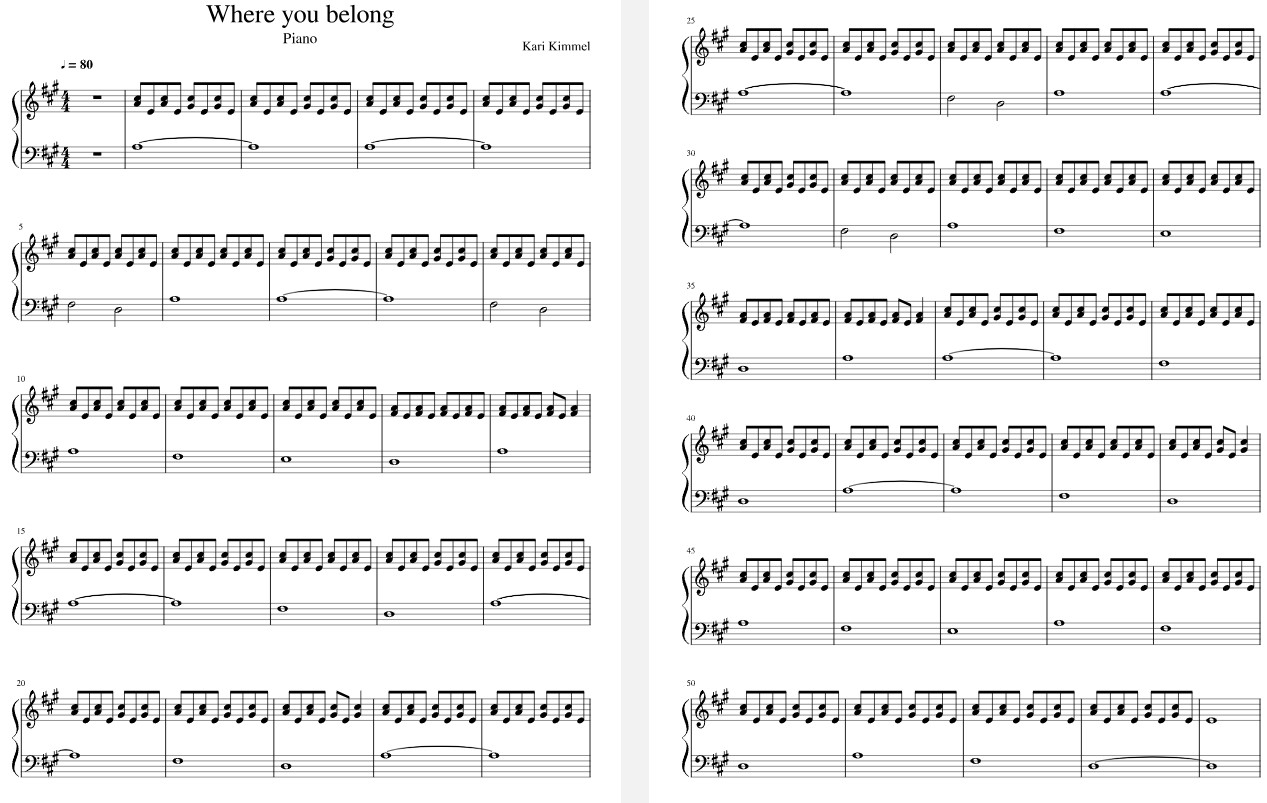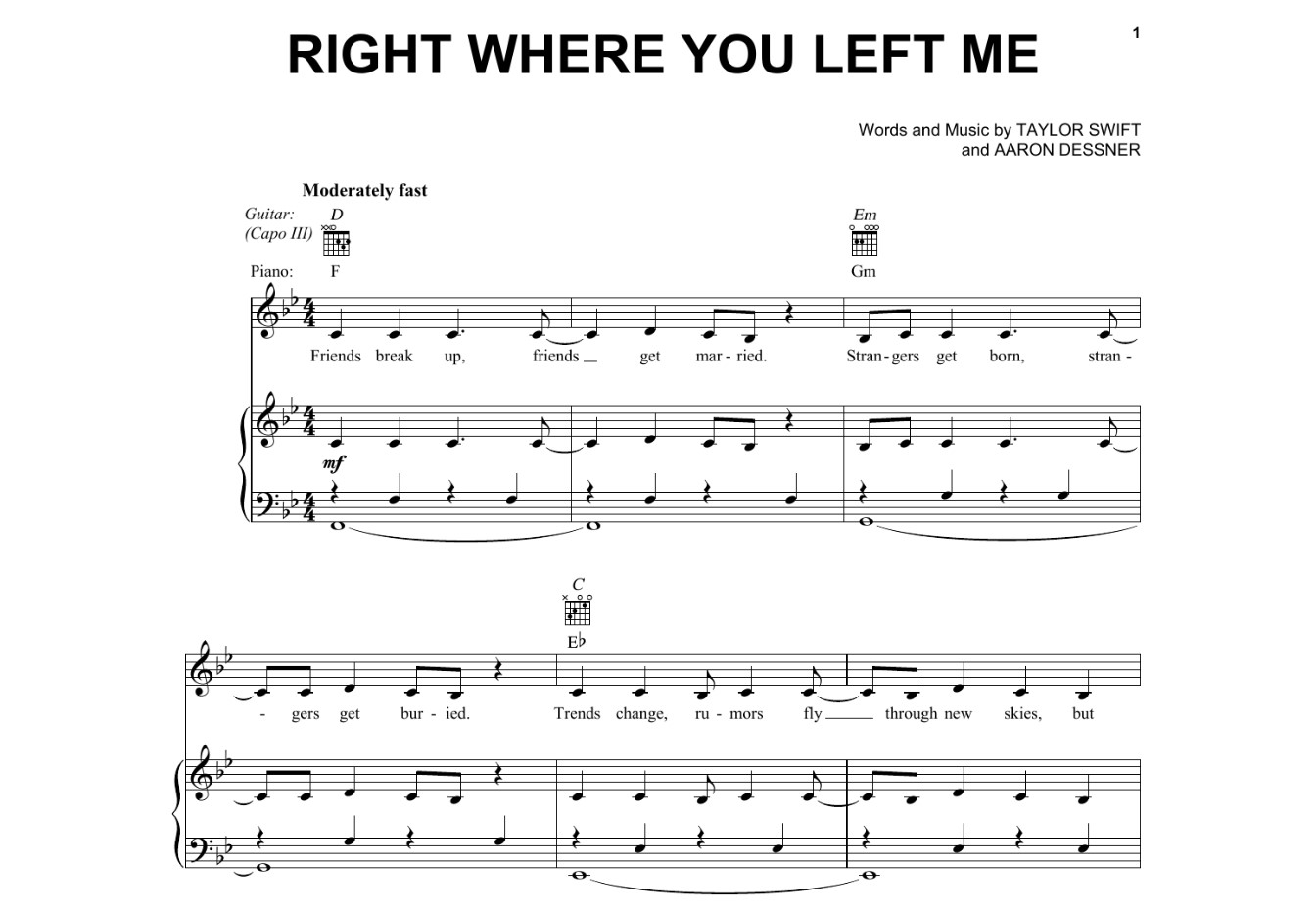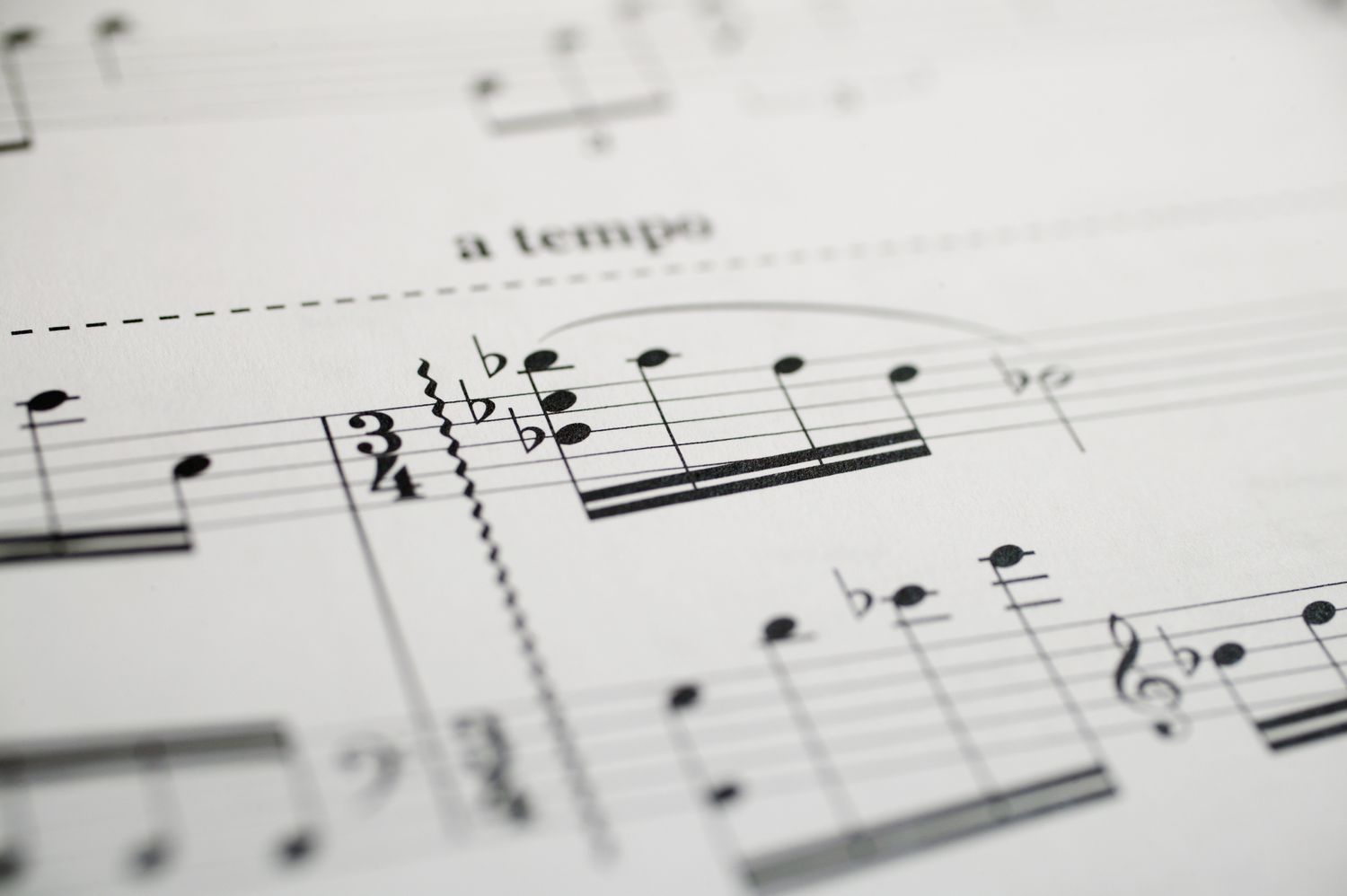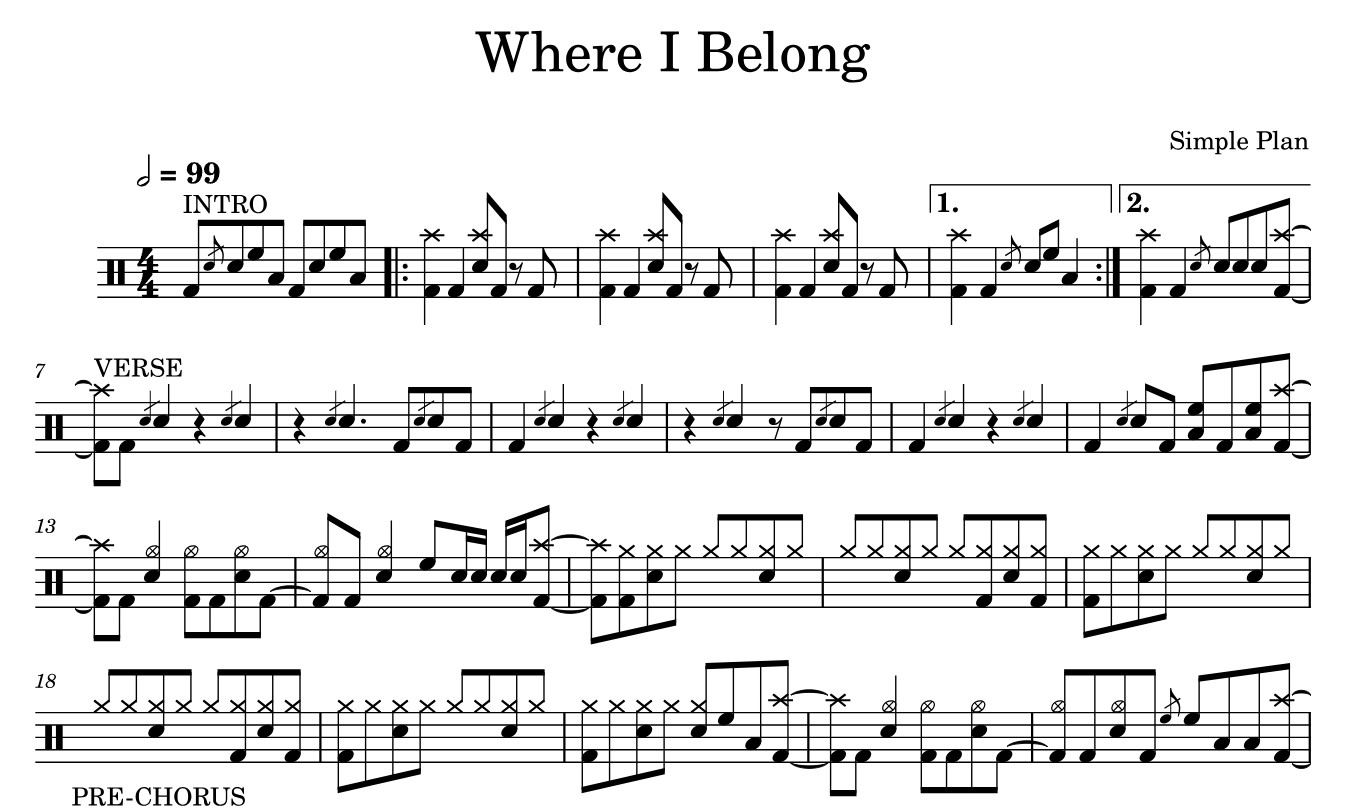Home>Production & Technology>Sheet Music>On The Street Where You Live Sheet Music
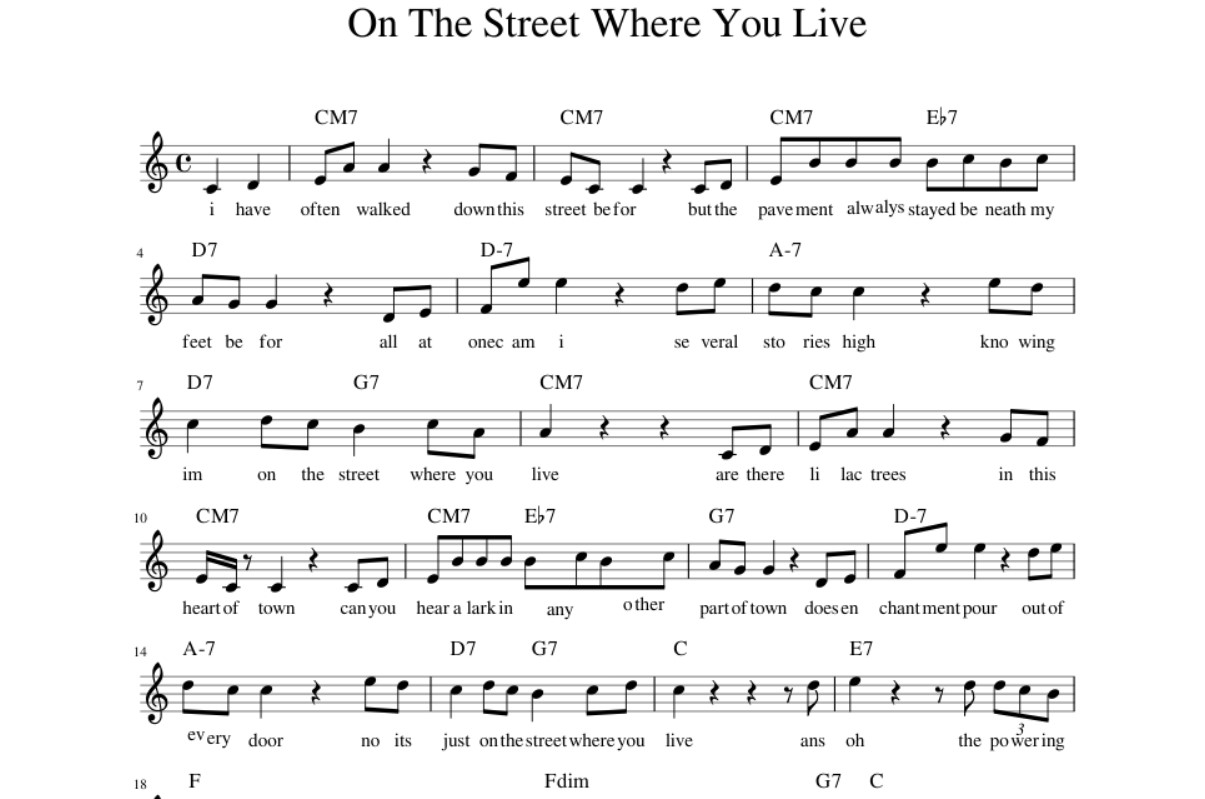

Sheet Music
On The Street Where You Live Sheet Music
Published: December 3, 2023
Looking for sheet music for "On The Street Where You Live"? Find and download the sheet music you need for this iconic song and more at our site.
(Many of the links in this article redirect to a specific reviewed product. Your purchase of these products through affiliate links helps to generate commission for AudioLover.com, at no extra cost. Learn more)
Table of Contents
- Introduction
- Background Information
- Overview of “On The Street Where You Live” Sheet Music
- Composer and Lyricist Information
- Musical Notation and Arrangement
- Key Signature and Time Signature
- Instrumentation
- Vocal Range and Lyrics
- Performance Techniques and Interpretation
- Popular Performances and Recordings
- Reception and Impact of “On The Street Where You Live”
- Conclusion
Introduction
Sheet music serves as a vital tool for musicians, allowing them to bring compositions to life through their performances. Among the thousands of iconic songs in the world of music, “On The Street Where You Live” stands out as a beloved classic. This timeless piece, with its captivating melodies and expressive lyrics, has continued to captivate audiences for decades.
In this article, we will explore the rich history and intricacies of “On The Street Where You Live” sheet music. We’ll delve into the background of the song, discuss its composer and lyricist, analyze the musical notation and arrangement, examine the vocal range and lyrics, and explore performance techniques and interpretation. Additionally, we will highlight popular performances and recordings of this musical masterpiece, as well as its enduring impact on the music industry.
Whether you are a pianist, vocalist, or music aficionado, this article will provide you with a comprehensive understanding of the sheet music for “On The Street Where You Live” and its significance in the realm of music.
Background Information
“On The Street Where You Live” is a song that was originally written for the Broadway musical “My Fair Lady,” which premiered in 1956. The musical, based on George Bernard Shaw’s play “Pygmalion,” tells the story of Eliza Doolittle, a Cockney flower girl, and her transformation into a sophisticated lady with the help of Professor Henry Higgins.
The song was composed by Frederick Loewe, with lyrics written by Alan Jay Lerner. Loewe was an Austrian-American composer known for his collaboration with Lerner on several successful musicals, including “Brigadoon” and “Camelot.” Lerner, on the other hand, was an American lyricist and librettist, renowned for his ability to craft witty and poetic lyrics.
“On The Street Where You Live” serves as a pivotal moment in the musical, as the character Freddy Eynsford-Hill expresses his infatuation with Eliza Doolittle. The song showcases the blossoming love Freddy feels when he sees Eliza, and his desire to be close to her, even if it means simply observing her from afar.
The musical was an instant success and received critical acclaim for its memorable songs, compelling storyline, and breathtaking performances. “My Fair Lady” went on to win six Tony Awards, including Best Musical, and later became a highly successful film adaptation in 1964, starring Audrey Hepburn and Rex Harrison.
The enduring popularity of “On The Street Where You Live” can be attributed to its universal theme of unrequited love and the timeless quality of its music and lyrics. The song’s emotional resonance and melodic charm continue to resonate with audiences of all generations, making it a cherished piece in the world of musical theater.
Overview of “On The Street Where You Live” Sheet Music
“On The Street Where You Live” sheet music captures the essence of the song’s beauty and complexity in a written form that allows musicians to bring it to life. The sheet music includes the musical notation, lyrics, and arrangement that are essential for musicians to perform the song accurately.
The sheet music typically consists of a series of musical staffs or staves, which represent the different musical parts of the song. Each staff contains a set of horizontal lines and spaces on which the notes and other musical symbols are positioned.
The melody of “On The Street Where You Live” is generally notated on the treble clef staff, which is the top staff in the music notation. The treble clef represents higher-pitched instruments and vocals, such as the piano, violin, or female voices.
Beneath the treble clef staff, the sheet music often includes additional staves for other musical elements, such as harmony, chords, and rhythm. These staves provide guidance for accompanying instruments or for musicians who want to perform the song with a fuller arrangement.
The sheet music also incorporates the lyrics of “On The Street Where You Live” below the musical staffs. The lyrics are written in sync with the corresponding musical notes, allowing the vocalist to follow along and sing with accuracy and expression.
Additionally, the sheet music may include additional markings, such as dynamics (indicating the volume of the music), tempo markings (indicating the speed at which the song should be played), and articulations (indicating the manner in which the notes should be played or sung).
For pianists, the sheet music for “On The Street Where You Live” often includes chord symbols above the musical staffs. These symbols provide the pianist with the flexibility to create their own accompaniment by playing the designated chords in a harmonically appropriate manner.
The sheet music not only serves as a guide for musicians but also allows for personal interpretation and creativity in performances. Musicians can add their own stylistic touches and improvisations while staying true to the overall structure and essence of the song.
Overall, the sheet music for “On The Street Where You Live” is a valuable resource that allows musicians to recreate the magic and allure of this timeless song, ensuring that its beauty continues to be cherished through live performances and recordings.
Composer and Lyricist Information
“On The Street Where You Live” was composed by Frederick Loewe, with lyrics written by Alan Jay Lerner. Both Loewe and Lerner were highly renowned and accomplished figures in the world of musical theater.
Frederick Loewe was born on June 10, 1901, in Berlin, Germany. He moved to the United States in 1924 and began his career as a piano accompanist and music director. Loewe’s collaboration with lyricist Alan Jay Lerner proved to be immensely successful, as they created a string of hit musicals in the 1940s and 1950s. Loewe’s music for “On The Street Where You Live” showcases his ability to compose beautiful melodies that resonate with audiences.
Alan Jay Lerner was born on August 31, 1918, in New York City. He initially pursued a career in journalism but found his true calling in writing lyrics for musical theater. Lerner’s clever and poetic lyrics brought depth and emotion to the songs he worked on, and his collaboration with Loewe yielded numerous Broadway successes.
Together, Loewe and Lerner created beloved musicals such as “Brigadoon,” “Camelot,” and of course, “My Fair Lady,” which featured “On The Street Where You Live.” Their partnership was an ideal blend of Loewe’s melodic compositions and Lerner’s eloquent and witty lyrics, resulting in songs that have become iconic in the world of musical theater.
Their work on “My Fair Lady” was highly acclaimed, receiving numerous awards and accolades, including the Tony Award for Best Musical. The success of the musical and its songs, including “On The Street Where You Live,” solidified Loewe and Lerner’s status as innovative and influential figures in the realm of musical theater.
Despite their individual strengths, both Loewe and Lerner recognized the importance of collaboration. Their collaboration on “On The Street Where You Live” showcases their combined talent, resulting in a song that remains a timeless classic in the musical theater canon.
Musical Notation and Arrangement
The musical notation and arrangement of “On The Street Where You Live” sheet music effectively capture the nuances and intricacies of the song’s melodies and harmonies. The arrangement provides guidance for musicians to bring the composition to life, whether it be for a solo performance or as part of a larger ensemble.
The sheet music presents the arrangement through a combination of musical notation, chords, and markings that convey the desired expression and interpretation of the song.
At its core, “On The Street Where You Live” is typically written in a major key, providing a bright and optimistic tone to the music. The key signature may vary depending on the vocal range and instruments being used for the performance.
The sheet music typically includes melodic lines written in both the treble and sometimes bass clefs. This allows for the accompaniment of various instruments or harmonizing vocal parts to be notated and performed accurately.
In addition to the melodic lines, the sheet music often incorporates chord symbols written above the staff. These symbols provide guidance for accompanists who can use the chords to create a harmonically rich and supportive backing for the melody.
Dynamics markings, such as pianissimo (very soft) or forte (loud), are also included in the sheet music to indicate changes in volume and intensity throughout the song. These markings help performers bring out the emotional and dynamic qualities of the composition.
The arrangement may also include specific instructions and notations for performance techniques, such as legato (smooth and connected), staccato (short and detached), or accents. These details add depth and character to the rendition of “On The Street Where You Live” and allow performers to infuse their own interpretations into the music.
The sheet music for “On The Street Where You Live” also provides a framework for various instrumental and vocal parts to come together in harmony. It guides musicians as they blend their individual contributions, creating a cohesive and captivating performance.
Whether a pianist playing the accompaniment, a vocalist interpreting the lyrics, or a member of an ensemble contributing to the overall sound, the sheet music of “On The Street Where You Live” serves as a valuable resource, allowing musicians to bring this enchanting composition to life in their own unique way.
Key Signature and Time Signature
The key signature and time signature are essential components of the sheet music for “On The Street Where You Live.” These musical notations provide important information about the tonality and rhythmic structure of the composition.
The key signature indicates the key in which the song is written. “On The Street Where You Live” is commonly written in the key of G major, although variations may exist to accommodate different vocal ranges or instrumentations. The key signature of G major consists of one sharp (F#) placed at the start of each staff, indicating that the notes F will be played as F# throughout the piece.
The choice of G major as the key gives “On The Street Where You Live” a bright and vibrant quality. This key allows for the use of higher registers and lends itself well to the joyful and romantic nature of the song.
In terms of the time signature, “On The Street Where You Live” is typically written in 4/4 time, also known as common time. The time signature indicates that there are four beats in each measure, and the quarter note receives one beat.
The 4/4 time signature provides a steady and accessible rhythm for performers and listeners alike. It maintains a sense of familiarity and allows for easy synchronization among multiple musicians or vocalists. The strong and consistent pulse of 4/4 time helps to drive the rhythmic energy of the song forward.
However, it is worth noting that in more interpretive or expressive performances, slight variations in tempo and rhythmic phrasing may occur, allowing musicians to add their own artistic touches to the piece without straying too far from the core structure and character of the song.
Understanding the key signature and time signature of “On The Street Where You Live” is crucial for musicians to accurately interpret and perform the piece. These notations provide a foundation upon which the musical elements can be built, allowing for a cohesive and cohesive rendition of this beloved composition.
Instrumentation
The instrumentation of “On The Street Where You Live” sheet music encompasses a variety of instruments to create a rich and harmonious sound. The arrangement allows for flexibility in choosing the instruments that best suit the performance and interpretation of the song.
Typically, the sheet music provides a foundation for a small ensemble or orchestra, but it can also be adapted for solo performances or smaller ensembles.
The primary instrument often featured in the arrangement is the piano. The piano provides the harmonic structure and serves as the backbone for the accompanying instruments or vocalists. Its versatility allows pianists to add their own unique interpretations and embellishments to create a captivating performance.
In addition to the piano, the arrangement may include a range of instruments, such as string instruments (violin, cello), woodwind instruments (flute, clarinet), brass instruments (trumpet, trombone), and percussion instruments (drums, tambourine). These instruments contribute to the texture and color of the arrangement, enriching the overall sound and adding depth to the song.
The specific combination and number of instruments can vary depending on the desired arrangement and available resources. Ultimately, the choice of instruments depends on the preferences and creative vision of the performers and arrangers.
For vocal performances, the sheet music includes vocal lines in addition to the instrumental parts. The vocal melodies and harmonies can be performed by one or multiple voices, depending on the desired effect. The sheet music may also indicate specific vocal techniques such as vibrato or dynamics to enhance the vocal performance.
It is important to note that while the sheet music provides a suggested instrumentation, musicians can adapt the arrangement to suit their needs or experiment with different instrument combinations. The goal is to create a cohesive and balanced sound that complements the lyrical and melodic elements of “On The Street Where You Live.”
Ultimately, the choice of instruments in the arrangement of “On The Street Where You Live” allows for a dynamic and expressive performance, highlighting the depth and beauty of the composition in a way that resonates with both musicians and listeners.
Vocal Range and Lyrics
The vocal range and lyrics of “On The Street Where You Live” sheet music are an integral part of the song’s emotional impact and storytelling. The arrangement of the sheet music provides guidance for vocalists to navigate the various melodic phrases and showcase their vocal abilities.
The vocal range of “On The Street Where You Live” typically falls within the baritone or tenor range. The song requires a vocalist who can deliver a warm and resonant sound with a hint of passion and vulnerability.
The sheet music outlines the melodic lines for the vocalist, indicating the specific notes and intervals they should sing. The melodies often encompass a range of emotions, including longing, infatuation, and hope, and offer opportunities for vocal expression and interpretation.
The lyrics of “On The Street Where You Live” beautifully convey the character’s romantic feelings and admiration for a loved one. The poetic and evocative words, crafted by lyricist Alan Jay Lerner, paint a vivid picture of love and longing.
The lyrics take the listener on a journey through the streets, capturing the excitement and joy of being near the person they desire. The words explore themes of love at first sight and the yearning to connect with someone on a deeper level.
Throughout the song, the lyrics evoke imagery and emotion, inviting the vocalist to infuse their performance with sincerity and vulnerability. The sheet music provides a roadmap for the vocalist to bring out the subtleties and nuances of the lyrics, highlighting the depth of emotion and storytelling within the song.
It is essential for vocalists to understand and connect with the lyrics of “On The Street Where You Live” in order to deliver a captivating and authentic performance. By bringing their own interpretation and understanding to the lyrics, vocalists can create a powerful and emotional experience for both themselves and the audience.
Overall, the vocal range and lyrics of “On The Street Where You Live” sheet music work in harmony to convey the depth of emotions and the heartfelt expression of love, making it a cherished piece for vocalists and audiences alike.
Performance Techniques and Interpretation
Performing “On The Street Where You Live” involves applying various techniques and interpretations to bring out the essence and emotions of the song. The sheet music provides a framework, but it is up to the performer to add their personal touch and creative expression. Here are some performance techniques and interpretation tips for delivering a captivating rendition of this beloved composition.
1. Expression and Dynamics: Pay attention to dynamics markings in the sheet music. Use crescendos and decrescendos to create a sense of ebb and flow, emphasizing the emotional peaks and valleys of the song. Apply subtle changes in volume and intensity to reflect the lyrical content and add depth to the performance.
2. Phrasing and Articulation: Explore different phrasing options to highlight the lyrics and musical phrases. Use legato (smooth and connected) and staccato (short and detached) techniques to bring out the subtleties of the melody and add expressiveness to the performance.
3. Tempo and Rhythmic Interpretation: While the sheet music provides a suggested tempo, don’t be afraid to experiment with different tempos to suit your interpretation. Play with rubato, subtly stretching or compressing certain phrases for added emotional effect. Ensure rhythmic accuracy, especially during syncopated passages, to maintain a strong sense of groove and momentum.
4. Vocal Style and Interpretation: Tailor your vocal style to the character and emotions portrayed in the song. Bring a sense of longing, warmth, and vulnerability to the lyrics. Explore different vocal colors and timbres to enhance the storytelling aspect of the song, allowing the audience to connect with the narrative on a deeper level.
5. Musicality and Nuances: Be attentive to small musical details such as ornamentation, trills, and subtle melodic variations that may enhance the overall performance. Add tasteful embellishments and improvisational elements while maintaining the integrity of the composition.
6. Connection with the Audience: Engage with the audience through eye contact, gestures, and body language. Connect with the emotions portrayed in the song and let that emotion resonate with your audience. Allow yourself to be vulnerable and authentic in your delivery, inviting the listeners to experience the depth of the music alongside you.
Remember, the interpretation and performance techniques for “On The Street Where You Live” can evolve and vary based on personal style, the overall arrangement, and the context of the performance. While the sheet music serves as a guide, it is important to bring your individuality and passion to make the song your own.
Ultimately, by applying these performance techniques and interpretations, you can deliver a heartfelt and captivating performance of “On The Street Where You Live,” creating an emotional connection with both yourself and your audience.
Popular Performances and Recordings
“On The Street Where You Live” has been performed and recorded by numerous artists over the years, solidifying its status as a beloved classic. Here are some notable performances and recordings of this timeless composition:
1. Original Broadway Cast Recording: The original Broadway cast recording of “My Fair Lady” features John Michael King as Freddy, delivering a passionate and heartfelt rendition of “On The Street Where You Live.” This iconic recording captures the essence of the song as it was intended in its original production.
2. Vic Damone: Vic Damone, a renowned American singer, recorded a beautiful rendition of “On The Street Where You Live,” showcasing his smooth and velvety vocal style. His interpretation adds a touch of romance and sophistication to the song.
3. Nat King Cole: Nat King Cole, one of the most influential and beloved vocalists of all time, lent his smooth and velvety voice to a memorable rendition of “On The Street Where You Live.” His interpretation combines impeccable phrasing with a deep emotional connection with the lyrics.
4. Frank Sinatra: Frank Sinatra, known as “The Voice,” showcased his mastery of interpreting romantic songs in his rendition of “On The Street Where You Live.” With his signature charm and elegance, Sinatra’s performance adds a touch of timeless class to the composition.
5. Harry Connick Jr.: Harry Connick Jr., a modern-day crooner and jazz pianist, offers a fresh and vibrant interpretation of “On The Street Where You Live.” His arrangement incorporates elements of swing and jazz, infusing the song with a new energy and dynamic flair.
6. Tony Bennett: Tony Bennett, a legendary vocalist renowned for his timeless interpretations, delivers a heartfelt performance of “On The Street Where You Live.” His smooth and emotive voice beautifully captures the essence of the song, showcasing his undeniable talent and musicality.
These are just a few examples of the many remarkable performances and recordings of “On The Street Where You Live.” Each artist brings their own unique style and interpretation to the composition, adding depth and resonance to the beloved classic.
Whether it’s the original Broadway cast recording or the renditions by iconic vocalists, each performance and recording of “On The Street Where You Live” showcases the enduring appeal and timeless beauty of this beloved song.
Reception and Impact of “On The Street Where You Live”
Upon its debut as part of the Broadway musical “My Fair Lady,” “On The Street Where You Live” quickly garnered acclaim and solidified its place as one of the most beloved songs of the show. Its impact reached far beyond the confines of the theater, resonating with audiences and leaving a lasting impression in the world of music.
The song’s lush and romantic melodies, coupled with its heartfelt lyrics, captivated listeners and critics alike. It became an instant hit, receiving widespread praise for its beautiful composition and the emotional depth it added to the storyline of “My Fair Lady.”
With its universal theme of love and longing, “On The Street Where You Live” struck a chord with audiences of all ages and backgrounds. The song’s ability to convey the emotions and experiences of infatuation and desire transcends time, resonating with listeners even today.
The impact of “On The Street Where You Live” extended beyond the success of the original Broadway production. The song has been performed and recorded by countless artists in various genres, solidifying its status as a classic piece of music that remains in the public consciousness.
Furthermore, the success of “On The Street Where You Live” contributed to the overall impact and popularity of “My Fair Lady.” The musical itself has become a staple of the theater, recognized for its memorable songs, compelling storyline, and timeless appeal.
Not only did “On The Street Where You Live” receive critical acclaim, but it also garnered numerous accolades and awards. “My Fair Lady,” including the song, won multiple Tony Awards, including Best Musical, showcasing the song’s significance in the success of the production.
Over the years, “On The Street Where You Live” has been covered and reinterpreted by artists in various musical styles, further cementing its impact and influence. Its melodies have been embraced by jazz musicians, vocalists, and instrumentalists, solidifying its place in the Great American Songbook.
The enduring popularity and impact of “On The Street Where You Live” serve as a testament to its timeless quality and the skill of its composer and lyricist. Since its inception, the song continues to evoke emotional responses and resonates with audiences, ensuring its place as a cherished and timeless piece of music.
Conclusion
“On The Street Where You Live” sheet music has stood the test of time, captivating audiences with its beautiful melodies, poetic lyrics, and timeless appeal. Composed by Frederick Loewe, with lyrics by Alan Jay Lerner, this beloved song has left an indelible mark on the world of musical theater.
From its debut in the Broadway production of “My Fair Lady,” “On The Street Where You Live” has enchanted listeners with its heartfelt expression of love and longing. Its popularity has transcended the realm of the stage, inspiring numerous performances and recordings by artists of different generations and musical styles.
The sheet music for “On The Street Where You Live” provides a guide for musicians to accurately interpret and perform the song, from its key signature and time signature to its vocal range and expressive lyrics. Musicians have the opportunity to add their own unique interpretations and musicality to make the song their own.
Throughout the years, “On The Street Where You Live” has garnered critical acclaim, received prestigious awards, and left a lasting impact on the music industry. Its universal themes and melodic charm continue to resonate with audiences of all ages, solidifying its place as a timeless classic.
Whether performed in a solo setting, as part of an ensemble, or by an iconic vocalist, “On The Street Where You Live” remains a beloved and cherished piece of sheet music. Its enduring popularity is a testament to the artistry of its composer and lyricist, as well as the emotional connection it creates with listeners.
So, whether you’re a pianist, vocalist, or music lover, explore the magical world of “On The Street Where You Live” sheet music. Let the melodies sweep you away to the streets of romance, and allow the lyrics to tug at your heartstrings. As you perform or listen to this timeless composition, remember the impact it has had on the world of music and the countless souls it has touched over the years.

